Clutch Bleeding (VTX 1800)
Posted by Bare | Last Updated May 27, 2014This is a walk-through for bleeding the hydraulic clutch on the VTX 1800 – the process should be identical regardless of the model. I see riders on all makes/models with clutch and brake fluid which is dark brown like Coca-Cola. I can only assume many of them don’t realize that this is a sign of old fluid which needs to be replaced. The performance of hydraulic fluid degrades slowly, so most people don’t even realize how bad the fluid is until they replace it via a bleed. Having clutch problems? Perhaps you just have old fluid – often times a quick bleed is just what you need to get the bike feeling “right” again.
Before you start this job, consider buying a vacuum pump as an alternative to a one-man bleeder kit. You can get these from Harbor Freight, Sears or most auto stores for about $30. If you plan to bleed your own clutch and brakes on the bike it’s well worth it. If you think you might use it on your friend’s bikes or to bleed the brakes on your car/truck/etc then it’s only more of a bargain. Since I bought mine I’ve used it more times than I can remember and each time is a reminder of how much easier it is versus the old hand pump method. Also if you ever plan to change your lines to braided stainless steel or do a break-down and rebuild of your hydraulic systems, a vacuum pump will help get air out of the lines that a regular bleed won’t easily get.
Keep in mind that if you’re rebuilding your brake hydraulic system or replacing your lines with braided ones and the system is completely dry it will take longer to bleed and will require more fluid. You must also be careful to get all the air out of the system or you can have problems such as poor braking or trouble getting into or out of gear with your clutch. You’ll have to do a combination of vacuum and pump bleeding in order to get all the air out of the master cylinders and banjo bolts. It’ll require some skill, some tapping on things and some patience to be certain you get all the air out because it likes to “hide” in these parts.
As with all projects undertake this at your own risk. This is a fairly simple process if you take your time and are careful. Don’t forget that brake fluid eats paint, so when you’re preparing remember to have a lot of rags handy to protect your paint!
What makes brake/Clutch fluid turn brown?
In its pure (fresh) form brake fluid cannot be compressed (unlike air and certain liquids) and it is designed to have extremely high boiling points. This makes it ideal for a brake and/or clutch system. Over time air slowly makes its way into your brake and clutch hydraulic system – this air contains small amounts of water vapor. Brake fluid absorbs this moisture from the air and the contaminants in the water discolor the fluid. This is why brake fluid containers are always labeled “only use fluid from a sealed container.” The water vapor and contaminants that infiltrate your hydraulic fluid lower its boiling point and make it slightly less effective. This results in that “spongy” pedal or lever you can feel with old fluid.
Synthetic fluid is designed to resist water absorption and therefore lasts much longer between bleedings. This is why I recommend and use Valvoline Synthetic DOT3 & 4 fluid. Another plus is that it’s clear so you can easily see when it’s time to replace it (it turns brown). It’s also readily available at most auto stores and only costs about 5 bucks per quart making it a great choice.
If you’re interested to learn more about brake fluid including the differences between DOT 3/4 fluids and DOT 5 you can read Biglry’s informative post in this thread.
How a bleeder screw works
The bleeder screw is what allows us to bleed a hydraulic system. The gray area represents what the bleeder is threaded into, whether it is a brake caliper, a clutch slave cylinder, etc. The red represents the fluid which is backed up behind the bleeder.
The hole in the side of the bleeder is connected inside the bleeder screw to the hole you see at the top of the bleeder. The top hole is where you attach the rubber hose when bleeding.
The taper on the end of the bleeder helps make a tight seal when the bleeder is snugged down. The area the taper sits on in the caliper, slave cylinder, etc is called the “seat”.
When you loosen the bleeder screw it allows fluid to flow past the seat, through the small hole on the side of the bleeder and out the top of the bleeder into the attached hose. Based on how this works you can see how important it is to be careful not to obstruct the hole in the bleeder near the seat. This is especially important if you’re removing the bleeder to put teflon on the threads.
Required Tools/Materials
- 5mm allen
- Phillips head screwdriver
- 10mm wrench – it must be a wrench, a socket won’t work.
- lots of rags to protect your paint and to catch spills. I also use an old sock to catch spills at the reservoir
- 1 pint of fresh (sealed) DOT4 brake fluid (a quart if you’re doing brakes too) – I use Valvoline Synthetic DOT3 & 4
- Mity-vac or other brake bleeding kit
- (Optional) bungee cord
Process
Before you start, COVER YOUR TANK!!!
Brake fluid eats paint so make sure you have sufficient protection in case you spill any fluid.
You can do this project on the sidestand or on a lift, but decide in advance. If you’re doing it on a lift you will need to bungee or tie the front wheel at full lock to the right side like this:
The last thing you want is to bump the wheel or have the wheel swing with the reservoir open and sling brake fluid (which eats paint) all over your bike. If you want to work on the bike on the ground then swing the wheel all the way to the right and the tire should provide enough friction (on level ground) to hold the reservoir level. If you’re still uneasy then I would recommend tying the wheel just to play it safe.
The key reason for doing all of this is to get the reservoir as level as possible. With most bars at full lock to the right you get this. If you have adjusted your bars so that the reservoir won’t level out this way, then you may need to break the riser clamps loose and rotate your bars so the reservoir sits level. Remember that if you break the clamps loose you have to snug the clamps tight once the bars are rotated or you might ding your tank and spill brake fluid everywhere – always better safe than sorry.
Now on the left side of the bike remove the seven 5mm allen bolts holding the chrome cover in place. Carefully remove the cover and set it out of the way so you don’t damage it. Now you have access to the clutch slave which is where you need to be to bleed the clutch.
Back to the reservoir – with it level wrap a sock or a towel around it to protect against any spills. I like old socks because they wrap nice and snug around the reservoir.
With the sock/towel wrapped around the reservoir, use a phillips head screwdriver to remove the 2 screws holding the cover in place. With the cover off have a rag handy to remove the “internals” under the cover.
If you have a chrome cover with chrome screws you can use a piece of heavy plastic (like most parts ship in) between the screwdriver and the screw to prevent nicking the chrome. The internals for the reservoir come out in the order they are shown in the picture. Set a rag aside and lay these parts on the rag while you bleed the system.
With the reservoir open, soak up the old fluid with paper towels and throw them away. Rather than pull this dirty stuff through the hydraulic system it’s better to clear it out now. With the reservoir empty, check the bottom because sometimes crud settles here and forms sludge. You can remove this sludge and clean the reservoir bottom with a few Q-tips. With the old fluid gone, top off the reservoir with fresh fluid before you start the bleeding process.
At this point you have to choose which type of bleeding you’ll be doing, vacuum bleeding or pump bleeding. After making your choice, click the appropriate header in the walk-through and proceed from there.
Vacuum bleeding
Keep in mind that a vacuum bleeder sometimes creates such a strong vacuum that you experience air leakage around the threads of the bleeder screw. This leakage results in tiny air bubbles in the fluid during the bleeding process (they resemble foam). This is normal when using a vacuum bleeder and should not be mistaken as a sign of trapped air in the system. If you are concerned about this inhibiting your progress then remove the bleeder screw and wrap it with teflon tape (like you use on plumbing fittings). The teflon tape helps seal the threads and prevents these tiny bubbles from occurring during bleeding. You should note though that this is not mandatory to ensure a good bleed.
Before you proceed, read the entire bleeding process below until you understand it. This will prevent having to figure out what you’re doing half-way through the process and possibly making a mistake which could make your work harder.
Bleeding any hydraulic system using a vacuum pump requires a balance of:
- Making sure you maintain pressure on the vacuum pump
- Making sure you don’t run the reservoir (on the handlebars) empty
- Making sure you don’t spill brake fluid on anything
- Making sure you don’t fill the entire vacuum pump reservoir
Remove the little rubber cover on the bleeder screw, in the pic below you can see I’ve already popped it off.
|
Place the 10mm wrench on the bleeder with enough space to swing the bleeder open about 1/4 to 1/2 turn and then firmly place the hose for the vacuum bleeder onto the bleeder screw. |
If you look closely there is a little ridge below the top of the bleeder. Make sure the hose gets over this ridge as it helps provide a good seal when you put the system under pressure from the pump. With this done, pump the vacuum until you have built up pressure. The manual for the pump specifies a PSI, but I just pump the crap out of it and it works fine.
Using the 10mm wrench crack the bleeder open 1/4 to 1/2 turn so that fluid starts to be drawn into the vacuum pump reservoir. At this point you want to keep a close eye on the handlebar reservoir. When the fluid gets close to the bottom of the reservoir, close the bleeder and top off the reservoir with fresh fluid from the container. Make it a habit to grab a rag when you pour so you can prevent spills and drips.
With the reservoir topped off check the pressure in the vacuum pump and crack the bleeder open again so fluid starts flowing. Keep an eye on both the reservoir and the fluid coming out of the bleeder. The idea is to make sure there are no air bubbles coming out from the bleeder. As you flush the old fluid out you should begin to see fresh clear fluid coming out at the bleeder.
Once you feel there is no more air in the system and you can see fresh fluid coming out at the bleeder, close the bleeder and squeeze the clutch lever a few times – it should feel solid not spongy. If it feels spongy, then bleed a little more to see if there is air trapped in the system. It may help to pump the clutch lever a little and tap the banjo bolts where the line attaches to the reservoir and the clutch slave. Sometimes air likes to “hide” in the banjo bolts. Keep at it until you have fresh fluid throughout the system and a solid feeling clutch lever.
Once you’re done bleeding skip down (past “pump bleeding“) to the “finishing up“ section at the bottom for the rest of the directions to button everything back up.
Pump bleeding
Before you proceed, read the entire bleeding process below until you understand it. This will prevent having to figure out what you’re doing half-way through the process and possibly making a mistake which could make your work harder. The process of pump bleeding a hydraulic system is a simple one that just requires a little coordination.
- Pump the clutch lever a few times to build pressure – on the last pump squeeze and hold the clutch lever
- Loosen the bleed valve 1/4 to 1/2 turn until fluid starts to flow from the bleeder and into the rubber hose
- When the fluid has stopped flowing (or slows down) close the bleeder – do NOT release the clutch lever until the bleeder is closed!!!
- Release the clutch lever slowly
- Check the level of fluid in the reservoir and top it off if necessary
- Repeat all of the above
Remove the little rubber cover on the bleeder screw, in the pic you can see I’ve already popped it off.
|
Place the 10mm wrench on the bleeder with enough space to swing the bleeder open about 1/4 to 1/2 turn and then firmly place the hose for the vacuum bleeder onto the bleeder screw. |
If you look closely there is a little ridge below the top of the bleeder. Make sure the hose gets over this ridge as it helps provide a good seal to prevent leaks. If you don’t have one of those little “one man bleeder kits” then place the other end of the hose into a container to collect the fluid as you bleed the system.
What you are doing is building pressure in the system using the clutch lever and releasing that pressure through the bleeder screw. You have to hold the clutch lever until the bleeder is closed or else the release of the lever will draw air into the system from the bleeder – I mentioned earlier why you don’t want air in the system.
Keep repeating the steps above until you get fresh fluid coming out of the bleeder and you feel there is no more air in the system. With the bleeder closed squeeze the clutch lever a few times – it should feel solid not spongy. If it feels spongy then bleed a little more to see if there is air trapped in the system, it may help to tap the banjo bolts where the line attaches to the reservoir and the clutch slave. Sometimes air likes to “hide” in the banjo bolts. Keep at it until you have fresh fluid throughout the system and a solid feeling clutch lever.
Once you’re done bleeding continue on to the “finishing up” section for the directions to button everything back up.
Finishing up
Remove the bleeder hose making sure not to spill any fluid. Tighten the bleeder snug but don’t really wrench on it, it only requires 4.3 ft/lbs to seal – hand tight with the wrench will suffice. Place the little rubber cover back on the bleeder.
With the bleeder closed go ahead and close up the reservoir so you don’t have any spills. Fill the reservoir with fresh fluid to the ridge inside:
|
Now slowly and carefully reinsert the inner parts in the reverse order you removed them. Carefully drop the float (4) into the reservoir, slide the diaphragm (3) into place and the set plate (2) should slide right into the diaphragm. With everything in place install the cover (1) and snug the screws down – these are hand tight as well only requiring 1.1 ft/lbs to seal. If you have a chrome cover with chrome screws remember you can use a piece of heavy plastic to prevent nicking the chrome. |
|
Now you can reinstall the chrome side cover. It only takes a few ft/lbs to tighten the bolts that hold the cover in place, so hand-tightening them with a wrench will suffice. Clean up any fluid you might have spilled, remove all the rags you had put down and if you bungee’d the front wheel undo it. |
That’s it – you’re done – congratulations!
Afterthoughts
This is a quick and easy job once you have the experience of doing it a few times. It can help cure some clutch problems and is ideally something you should do as regular maintenance about once a year depending on how many miles you log on the bike. By using a clear fluid like Valvoline Synthetic you can tell by a quick glance at the sight glass when it is time to replace it. If you bleed your brakes and clutch at the same time you’ll even be able to tell which you use more often by which discolors sooner.
It’s easy to overlook your hydraulics because they degrade so slowly that you don’t really notice a difference until you have new fluid in the system. I challenge you to try this if you haven’t replaced your hydraulic fluid in over a year. You might think your brakes or clutch are doing just fine, but after replacing the old fluid you will notice a drastic difference in the feel of the lever. It’s hard to realize how much you’ve lost until you do this.
Video courtesy of Big Bad
This video is intended to give you an idea for the kind of things you’ll see and do during this job. It is not intended to replace the above instructions for anyone except experienced mechanics because the text above contains important details.

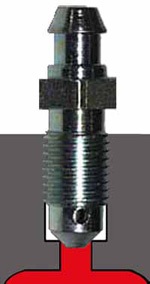
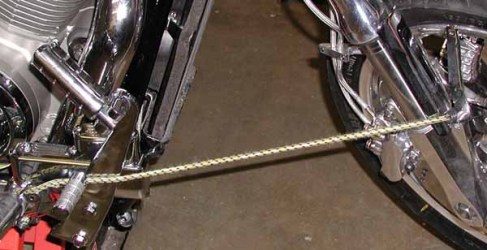
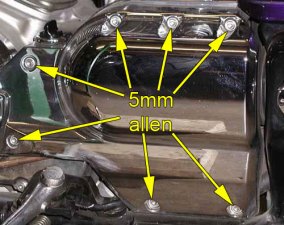
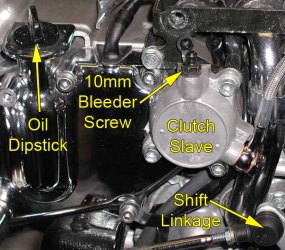
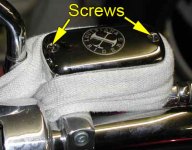
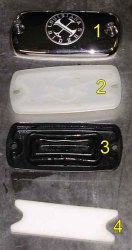
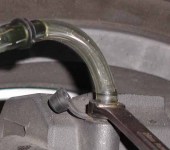
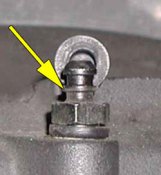
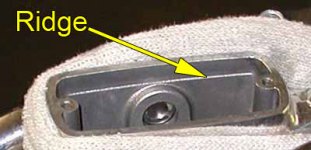
Thanks you so much for this detailed posting. I took my 2003 VTX 1800 out for the first ride of 2011 over the weekend. I got this bike only last spring and it worked fine all summer and into the fall. Right away I noticed the clutch was spongy and shifting was diffucult at best…nearly impossible at other times. After I managed to get home I surfed the web and came upon your posting. I figured I had air in the clutch line. I got Valvoline DOT 3 / 4 brake fluid ($7.50 at Auto Zone) and 2 feet of 3/16th inch ID vinyl tubing ($0.42 at Lowes) and got busy. From start to finish the whole process took me about an hour, including reassembly and clean up. The old brake fluid in the line came out thick and was the color of watered down coffee. I suspect it had never been changed. I probably would never have attempted this or known the cause of the problem if it were not for your post. I bet you saved me a hundred dollar service charge from the local bike shop. Thanks again! After seeing how easy that was I think I’ll change the brake fluid and follow your instructions for that too.
Check out this link. It shows exactly what you have written out. I found both the youtube vid and your detailed instructions invaluable.
Tom V.
http://www.youtube.com/watch?v=yn4LPoYNYUQ&feature=related
Thanks for a great site! Instructions are flawless.
Thanks for the great instructions! Pretty much like automovie bleading, but the added info was good. My clutch engage point was almost all the way out before bleeding, is in the normal range now.
I finished bleeding the clutch, then the brake system, did the desmog-pair valve removal, I also did my own version of an aibox mod, and then did the seat pin mod. Thanks for a Great Tech site!!! I am probably the most wrench challenged cowboy on the planet, but, following all the diretions from here and what I have learned on VTXOA site, it turned out Very good
Thanks Again,
BarefootCowboy
Thanks for the breakdown. I am going to the store to get a vacuum pump. I changed the hose on my ’02 VTX1800 ( the hard part) and needed to add the fluid and bleed, but I have spent more time on the last part than the connecting a new line. I suspect that there are those hidden air pockets that I cannot get to and get out of there. I will try again and hopefully succeed! This is my everyday rider and my butt is getting sore from racing my bicycle to work 16 miles away. ahhhhhhh!
Thanks again for the tips. Ride on!
Did the clutch and brakes tonight. Man you are correct there was a bunch of junk in the. Bottom of both master cylinders and the clutch bleader had so much gunk it was pluged. I have a 2003 1800c with around 30k on it so I was a little surprised.
Thank you for all your help!
[…] some air in the system and worked up to the reservoir. ???? Here is a link for bleeding […]
Just wanted you to know how appreciated your postings have been and ARE and a constant reference for me and many others. Just reminded myself to tape threads on clutch slave bleed after several unsuccessful attempts to remove excessive air. Might mention the vac pump no longer available from Harbor Freight for ~$30, but Amazon still a bit less (Mity-mite).
Thanks Bare.
rebuilt master and slave cylinder 2005 vtx 1800 and cannot get it bleed out
Great video, makes it look easy!
on the following step –Using a Vacuum pump
Are we squeezing the clutch level with the reservoir cap off? Just after finishing the fluid cycle?
Once you feel there is no more air in the system and you can see fresh fluid coming out at the bleeder, close the bleeder and squeeze the clutch lever a few times
Thank you for the instructions– I bought a mini vac china special -(BTSHUB brand) Pneumatic brake fluid bleeder tool from amazon (19.79)- worked like a charm— fixed my wonky spongy clutch engagement issue. Next up are the front brakes. Those appear even more easier than the clutch.
Thanks again.